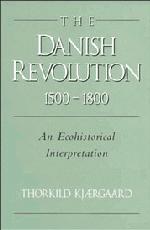Book contents
- Frontmatter
- Contents
- List of Illustrations
- Figure 1 The Danish States: Denmark, Norway, and Schleswig-Holstein in the eighteenth century
- Preface
- Figure 2 Denmark in the eighteenth century
- The Danish Revolution 1500–1800
- Introduction
- Part I Denmark, 1500–1750: A Country in an Ecological Crisis
- Part II The Ecological Revolution
- Part III The New Denmark
- 5 Landscape
- 6 Labour Burden and Social Structure
- 7 The Disease Pattern
- 8 Power
- Part IV The Driving Forces behind the Danish Revolution, 1500–1800
- Part V The Inheritance
- Appendix 1 Currency, Weights, and Measures
- Appendix 2 Reigns of Danish Kings and Queens
- Sources and Bibliography
- Index
8 - Power
Published online by Cambridge University Press: 03 May 2010
- Frontmatter
- Contents
- List of Illustrations
- Figure 1 The Danish States: Denmark, Norway, and Schleswig-Holstein in the eighteenth century
- Preface
- Figure 2 Denmark in the eighteenth century
- The Danish Revolution 1500–1800
- Introduction
- Part I Denmark, 1500–1750: A Country in an Ecological Crisis
- Part II The Ecological Revolution
- Part III The New Denmark
- 5 Landscape
- 6 Labour Burden and Social Structure
- 7 The Disease Pattern
- 8 Power
- Part IV The Driving Forces behind the Danish Revolution, 1500–1800
- Part V The Inheritance
- Appendix 1 Currency, Weights, and Measures
- Appendix 2 Reigns of Danish Kings and Queens
- Sources and Bibliography
- Index
Summary
Parce que vous êtes un grand seigneur, vous vous
croyez un grand génie! … noblesse, fortune, un
rang, des places; tout cela rend si fier! qu'avez-vous
fait pour tant de bien? Vous vous êtes donné
la peine de naitre, et rien de plus: du reste homme
assez ordinaire!
Beaumarchais, 1784We both have – my friend! – the same goal: to overthrow
the power of the nobility and the despotism of privilege and
to consolidate the liberty of the people; … the Government
must be brought to the point where it feels that the Throne
has no other reliable support upon which to rest than
the productive classes, the prosperity and love of truly
active citizens.
Knud Lyne Rahbek to P. A. Heiberg, 1794On the periphery of the complexity of nonlinear transformations created by the ecological revolution lay a new and different power structure. During the period 1500–1800 an intense struggle for power took place between two important factions within the Danish elite: a decentralized, aristocratic faction whose origins were lost in the tribal society of prehistory, and a new, rival faction gathered round the central royal power, whose existence cannot be traced further back than to the ninth or tenth century. The ecological revolution became a factor of great importance to the outcome of this struggle.
THE DANISH POWER STRUCTURE FROM THE VIKING AGE UNTIL 1766: THE RULE OF THE ARISTOCRACY
As far back as records can be traced, the power structure in ancient Danish society was decentralized, dominated by local and regional chieftains and aristocrats against whom the central royal power was incapable of asserting itself to any serious degree.
- Type
- Chapter
- Information
- The Danish Revolution, 1500–1800An Ecohistorical Interpretation, pp. 198 - 244Publisher: Cambridge University PressPrint publication year: 1994

